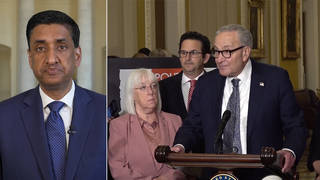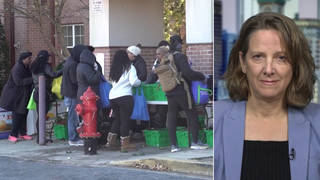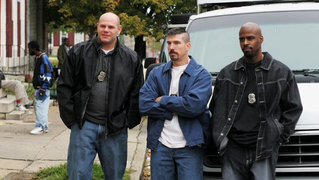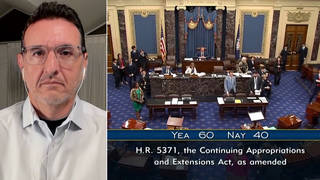
Guests
- David Simonjournalist and television writer best known for creating the HBO series The Wire and Treme. He is a former journalist at The Baltimore Sun. His newest project is the mini-series Show Me a Hero, now airing on HBO.
Today we spend the hour with David Simon, the man behind “The Wire,” what some have described as the best television series ever broadcast. His latest project is titled “Show Me a Hero,” a six-part mini-series now airing on HBO. It looks at what happened in Yonkers, New York, in the 1980s when the city was faced with a federal court order to build a small number of low-income housing units in the white neighborhoods of his town.
Transcript
AMY GOODMAN: Today we spend the hour with David Simon, the man behind The Wire, what some have described as the best television series ever broadcast. Nearly a decade ago in Slate, Jacob Weisberg wrote, “No other program has ever done anything remotely like what this one does, namely to portray the social, political, and economic life of an American city with the scope, observational precision, and moral vision of great literature.” President Obama met with David Simon earlier this year and described himself as a big fan.
PRESIDENT BARACK OBAMA: At the front end, I’ve got to tell you, I’m a huge fan of The Wire. I think it’s one of the greatest, not just television shows, but pieces of art, in the last couple of decades. I was a huge fan of it.
AMY GOODMAN: President Obama, speaking at the White House during a meeting in March with David Simon. In The Wire, Simon captured the city of Baltimore from the angles of street-level drug dealers, beat police officers, journalists covering corrupt politicians. David Simon said he aimed to portray how, quote, “raw, unencumbered capitalism” devalues human beings. He created the show after leaving The Baltimore Sun, where he worked on the city desk for over a decade. The Wire helped launch a new national discussion about the failings of the criminal justice system and the so-called war on drugs. In 2011, then-Attorney General Eric Holder urged Simon to do another season of The Wire. Simon responded he was prepared to do so if the Justice Department would, quote, “reconsider and address its continuing prosecution of our misguided, destructive and dehumanizing drug prohibition.”
Well, after The Wire ended, David Simon went to create Treme, looking at New Orleans after Hurricane Katrina, which hit the city 10 years ago this week. In 2010, Simon was awarded a MacArthur Genius award. In a statement summarizing his work, the MacArthur Foundation said, quote, “With the nuance and scope of novels, Simon’s recent series have explored the constraints that poverty, corruption and broken social systems place on the lives of a compelling cast of characters, each vividly realized with complicated motives, frailties, and strengths.”
David Simon’s latest project is titled Show Me a Hero. It’s six-part mini-series now airing on HBO. It looks at what happened in Yonkers, New York, in the 1980s when Yonkers was faced with a federal court order to build a small number of low-income housing units in the white neighborhoods of his town.
NICK WASICSKO: [played by Oscar Isaac] Well, don’t tell anybody, but I always wanted to be the mayor. I used to talk about it all the time growing up. The other kids used to call me the mayor.
NAY NOE WASICSKO: [played by Carla Quevedo] Really.
NICK WASICSKO: It wasn’t a compliment.
UNIDENTIFIED: The city intentionally segregated its housing for 40 years.
UNIDENTIFIED: The whole damn city government’s white.
MARY DORMAN: [played by Catherine Keener] This judge wants to take low-income housing and put it here, in East Yonkers.
HANK SPALLONE: [played by Alfred Molina] The trash, the drugs. We will die from what the city is trying to shove down our throat.
UNIDENTIFIED: I live here, and I am nothing like what they describe.
VINNI RESTIANO: [played by Winona Ryder] So what are you going to do?
NICK WASICSKO: It’s that guy from Yonkers again, asking if he can get any help from the state of New York.
PROTESTERS: No justice, no peace!
NICK WASICSKO: The matter with these people?
ROBERT MAYHAWK: [played by Clarke Peters] You wanted to live somewhere better, but everything has a cost.
HANK SPALLONE: It’s time you recognized your failure as a leader.
NORMA O’NEAL: [played by LaTanya Richardson Jackson] You want to live where people were angry at you?
NICK WASICSKO: You know, it’s all property values and life and liberty. Underneath it all, it’s fear. I played into that fear, too.
JUDGE LEONARD B. SAND: [played by Bob Balaban] Quite a year for you, Mr. Mayor. Justice is not about popularity.
NICK WASICSKO: No, it’s not. But politics is.
AMY GOODMAN: Highlights from the new HBO miniseries, Show Me a Hero. Joining us for the hour is the show’s creator, David Simon.
Welcome to Democracy Now!
DAVID SIMON: Thanks for having me back.
AMY GOODMAN: It’s great to have you with us. Tell us the story of Yonkers and desegregation.
DAVID SIMON: Well, it was one of the first places where a sort of a new generation of public housing policy was undertaken, which is to say there were a lot of mistakes that happened in the '50s, ’60s, ’40s even, in terms of the construction of public housing. Condensing everything into high-rise projects or mass—sort of mass incarcerating your poor in very tiny areas, like the—you know, Robert Taylor or Cabrini-Green in Chicago, or in my city in Baltimore, Lexington Terrace or Murphy Homes, it proved incredibly destructive and destabilizing to those neighborhoods, and it creates almost permanent ghettos. And so, the new revolution of scattered site housing kind of began in Yonkers, which was to say, a few units here, a few units there, don't destabilize the neighborhood, truly try to integrate your poor into the rest of society.
And it actually was a quiet revolution that was successful. Unfortunately, everybody who heard that 200 units had to be built in white areas, because of a court settlement, imagined the past and not the future. And so, it aroused incredible white anger, in the late '80s and early ’90s, and incredible upheaval. And you could not convince anyone to risk even the slightest of their property values or of the status quo in order to try to achieve the result. And so, Yonkers blew up. And it was—in winning the victory that they did, the cost, the political cost, was so exhausting that it wasn't replicated elsewhere around the country.
AMY GOODMAN: Let’s go to another clip from Show Me a Hero, showing one of these heated meetings in Yonkers over public housing.
PROTESTERS: Don’t you dare! Don’t you dare! Don’t you dare! Don’t you dare!
NICK WASICSKO: [played by Oscar Isaac] As indicated by our last vote, we elected to appeal the affordable housing portion of the judge’s order to the Supreme Court, but the Supreme Court has refused—
PROTESTER: Appeal all of it, you coward!
NICK WASICSKO: Roll call, Mr. Clerk. Roll call.
CLERK: [played by Ray Iannicelli] Mayor Wasicsko.
NICK WASICSKO: Aye.
CLERK: Vice Mayor Spallone.
HANK SPALLONE: [played by Alfred Molina] No.
CLERK: Majority Leader Cola.
CHARLES COLA: [played by Daniel Oreskes] No.
CLERK: Minority Leader Longo.
NICHOLAS LONGO: [played by Jim Bracchitta] No.
CLERK: Councilmember Fagan.
EDWARD FAGAN: [played by Allan Steele] No.
CLERK: Councilmember Chema.
PETER CHEMA: [played by Danny Mastrogiorgio] No.
CLERK: Councilmember Oxman.
HARRY OXMAN: [played by Dan Ziskie] Abstain.
CLERK: I have one aye, five nays, one abstention. The measure fails.
NICK WASICSKO: Meeting adjourned.
AMY GOODMAN: There you have one of those moments. Now, let’s go back, David Simon. Talk about what forced the desegregation.
DAVID SIMON: It was a court ruling by a federal court that was upheld by—well, it was ultimately upheld by the Supreme Court, but—
AMY GOODMAN: But this was a lawsuit brought by the NAACP?
DAVID SIMON: Absolutely. It came out of the Carter Justice Department in '79, was the original suit. And then the NAACP joined it as a friend of the court. And it was fought—it actually wasn't settled completely until 2007. That’s how long the litigation took. Basically, what was proven, beyond any doubt—I mean, it was upheld by a three-judge panel, including two Reagan appointees, the original decision. But what was proven was that Yonkers, like many American cities, like most American cities, used their federal housing money to purposely and willfully segregate their low-income housing. They used it for racial hypersegregation. And the case was proven by going back to, you know, even the minutes of the Housing Authority, for decades. You would hear people saying bluntly, “Well, don’t put it anywhere else but here. We don’t want—we don’t want blacks moving into that neighborhood or this neighborhood. Keep it”—so they built every single unit of low-income housing in one square mile of Yonkers.
AMY GOODMAN: So they used federal money—
DAVID SIMON: Right.
AMY GOODMAN: —to further segregate the city.
DAVID SIMON: Right. And, of course, you know, anybody who’s read Nick Lemann’s Promised Land or, notably, recently, Ta-Nehisi Coates’s reparations piece in The Atlantic, the case is definitive that—I mean, just definitive, that the country as a whole has used social engineering to create this hypersegregated world. I mean, we had done this as a matter of policy, of plan, of purpose for the last 40 years, 50 years, up to this point.
So here comes the NAACP and the Justice Department, that basically says, “Look, you took the money, and you did this, you know, contrary to Brown v. Board of Education. You know, this is a Plessy v. Ferguson type behavior. You can’t do this. This is depriving people of their constitutional rights.” And the remedy, of course, was desegregate your public housing stock. And they asked to build 200 units in a city of 200,000 on the white side of the Saw Mill River Parkway.
AMY GOODMAN: And it was going to be in different places.
DAVID SIMON: Right. Well, that’s the part that eluded the opponents, which was, there were people who had learned something about public housing and about the mistakes of public housing and of this very active hypersegregating all of your poor into one small area. And it was the beginning of scattered site housing and defensible space theory and a lot of things that actually work in terms of integrating the poor with the rest of society.
AMY GOODMAN: What’s the difference between segregation and hypersegregation?
DAVID SIMON: Degree, degree. I mean, I would say that, you know, certainly, when you are trying to place every single person of color in a context where they are not interacting with the rest of society, if you were to go to look at the Schlobohm high-rise projects, which are still there in West Yonkers, they’re actually built in this incredible gully in the middle of West Yonkers with a high retaining wall, so that—I mean, there’s a 20-foot retaining wall around it. I mean, you look at it, and you realize the poor are being made to—
AMY GOODMAN: They are—it’s like a walled-in community.
DAVID SIMON: It’s like in a gully, and there’s a 20-foot wall that surrounds it. I mean, it is so segregated from the rest of Yonkers that the intent is absolutely clear, which is: Let’s make no mistake, this is where we took the money—we took the—for the housing stock. And by the way, the people—let’s be honest, the reason cities started taking the federal money was these projects originally—not the Schlobohm, but the ones before that, the low-rises, Mulford Gardens, places like that—in every city, they were for white people. They were for people struggling to hold families together at the end of the Depression, and some of the earlier projects go back to the ’30s. And particularly after the war, after World War II, they were for returning veterans. And they were heralded. Public housing was heralded as a viable and advantageous federal policy. It was only when it gravitated to people of color, when they became the next immigrant wave, either from the South or from other countries, that it became problematic politically.
AMY GOODMAN: David, I want to go to another clip from Show Me a Hero. Here, a representative with the Housing Education Relocation Enterprise program speaks with the Mary Dorman, a main character in Show Me a Hero, played by Catherine Keener, an older East Yonkers resident.
ROBERT MAYHAWK: [played by Clarke Peters] As I began to explain, I run a group called the Housing Education Relocation Enterprise, or HERE. We have been commissioned by the Yonkers Housing Authority to help these tenants move into the new homes—thank you—and to do so in the best possible way for the tenants and for the existing neighborhood residents. We intend to make sure that what is going to happen, happens in the best possible way for everyone. May I ask, Mrs. Dorman, how do you feel about the housing presently?
MARY DORMAN: [played by Catherine Keener] Honestly?
ROBERT MAYHAWK: But of course.
MARY DORMAN: Honestly, I don’t—I don’t believe in it.
ROBERT MAYHAWK: You don’t believe in the purpose of the housing, or you don’t believe that the housing is coming to your neighborhood?
MARY DORMAN: I don’t believe in the idea of it. I know the housing is coming.
ROBERT MAYHAWK: It is. Oh, pardon me. You are exactly right, it is going to happen. And what is left for all of us to decide is exactly what it will be, or more importantly, perhaps, what it will not be.
AMY GOODMAN: This woman, Mary Dorman, is a very interesting figure, one of the leading activists against desegregation, who begins to change, David Simon.
DAVID SIMON: Yeah, she had an incredible journey. I got to meet her before she passed, because we started research on this project back in about 2002, 2003.
AMY GOODMAN: It’s based on the former New York Times reporter Lisa Belkin’s book.
DAVID SIMON: Lisa Belkin’s book. And Bill Zorzi and I, who worked on the scripts, we felt the need to—we have to get the voices, as well, as well as the prose story. So we went to Yonkers, and Bill, particularly, dug into the story, and of course he met Mary. And Lisa tells a fascinating story about reading to Mary her book, when she was finished with the manuscript. Mary is reading visions of herself from when she was one of the most vocal and furious opponents of the public housing, and she denied saying those things. And Lisa had to go back and show her the record, what she had said at hearings and at protests. And Mary, at that point in life, didn’t recognize herself. She didn’t recognize her earlier version of herself. She was astonished. It really was a hero’s journey for her. And she’s—you know, Catherine Keener plays the turn so beautifully.
AMY GOODMAN: Now, you show the wrath of this section, this segment of the white community against the desegregation.
DAVID SIMON: Right. People think it’s hyperbolic. People think that we sort of exaggerated it. All you’ve got to do is go to—there are documentaries, there’s film footage of the council hearings. I mean, we’re going verbatim.
AMY GOODMAN: But what about the black community and where they stood on this? There’s a point early on where you have—I think he was a leader of the NAACP, sort of throwing up his hands and saying, “This isn’t even worth it anymore, 200 houses.”
DAVID SIMON: There was a level of exhaustion. By the time we come into the story, we’re at 1987. And there had been a remedy ordered in 1985. The case had dragged on for six years. There had been repeated attempts to settle the case out of court, that had failed because the Yonkers City Council couldn’t even approve one unit of public housing anywhere, so that, you know, even more benign—I mean, there was one settlement that had called for only 100 units, but the council vetoed that. So, you know, you’re talking about a level of exhaustion on the part of black activists, that by ’87 the attorney, one of the attorneys who brought the case, Michael Sussman, he told us he clearly felt as if the fact that this was incredible precedent, legal precedent, that they had established, that cities that did this were—the remedy had to be an attempt to desegregate, even on the part of the advocates, there was a level of exhaustion because of the resistance.
And there is to this day. Yonkers stands as—if you go to those townhouses that they built, they’re not a source of additional crime. They didn’t bring down the neighborhoods. The property values remain fairly constant. In fact, they’re increasing now because of Yonkers’ availability, a sort of renaissance downtown. But that’s the victory on the ground. The emotional cost of it—you know, I mean, the federal government had the—the same dynamic in Dallas right now, going on right now, is going on in Dallas, and the federal government doesn’t have the—HUD doesn’t have the stomach to fight it through. They’re basically pulling up stakes and giving up on the case.
AMY GOODMAN: I mean, the judge forced this through by basically saying, “We will bankrupt Yonkers if you don’t follow through.”
DAVID SIMON: Well, yeah. Yonkers was in contempt.
AMY GOODMAN: Every day another fine.
DAVID SIMON: At a certain point—I mean, at a certain point, there had been this decision, it had been appealed, the appeal had been upheld, and Yonkers still wasn’t obeying a federal court order. At that point, a federal judge has remarkable power, if he wants to use it, to enforce an order, to enforce a legal order. And Yonkers was—he was going to fine the city to the point of bankruptcy. And Yonkers still couldn’t get four votes on the council to approve a housing plan.
AMY GOODMAN: But you’re not seeing the backbone of Obama’s HUD, of the Obama administration, in Dallas to push this forward?
DAVID SIMON: Well, not in Dallas. I mean, I think they’ve done—you know, they’re using, I think, these last two years very effectively. And I think you’re seeing—you know, the opening up of the data for local groups to now pursue these cases on their own, I think, is a very effective thing that they’ve done. But, yeah, I think in Dallas you’ve seen, yeah, I would have to say, a lack of backbone. And there haven’t—you know, if you think these problems are—that we did something that’s 25 years old and it’s an anachronism, two towns up the Hudson right now, in Tarrytown, this same rhetoric, the same demagoguery, same guys running for office claiming that they can in some way turn back this decision. They’re finding it in Tarrytown now instead of Yonkers. So—
AMY GOODMAN: And in Yonkers, the mayor, Nick Wasicsko, he ran on an anti-desegregation platform, and simply because of the judge saying he was going to bankrupt the city—I mean, it wasn’t a moral awakening, though it came to be one, it seems like.
DAVID SIMON: It came to be one. Nick grew, too.
AMY GOODMAN: Yeah.
DAVID SIMON: You know, obviously, we spent a lot of time talking to his widow, Nay Wasicsko. And he came to see that—you know, in the beginning what it was, was a political opportunity to run to the right of the existing mayor, who was ready to comply. And Nick was arguing that they should still exhaust every possible appeal, even though everyone in city government knew there were no grounds for appeal. So, almost before, I would say a couple weeks before his inauguration, after he won, running to the right of the mayor, the call comes from the lawyers, and they say, “We lost the appeal. You’ve got to do it.” And Nick then had to turn around to the voters and say, “I know what I ran on, but, hey, we lost the case. Now we have to build the units.” And that was not well received.
AMY GOODMAN: And what captured your imagination? I mean, you dig in. You throw yourself completely into these projects. In a moment, we’re going to talk about New Orleans in Treme and then The Wire.
DAVID SIMON: I thought this piece was—you know, there’s been a lot of writing about the American pathology of race and how it’s an overlay on all of our urban problems, our failure to deal with it. I mean, it still—it remains for the 21st century the most fundamental question of, well, if we don’t get this right, it’s problematic that we’re going to get the city right. If we don’t get the city right, I don’t see how this society becomes anything but second-rate, because we are an urban people. And, you know, if you’ve read anything about the construct of segregation and what it’s done in terms of creating these two separate Americas—you know, Andrew Hacker’s book, Two Nations, or The Promised Land by Nick Lemann or—I mean, there’s just so much reporting that basically says this is the great stumbling block of American society. It’s what we’ve—you know, we’ve wasted an incredible amount of treasure, time and lives because we can’t get this right.
AMY GOODMAN: We’re talking to David Simon for the hour, the former Baltimore Sun journalist. Baltimore Sun figures prominently in the remarkable series, The Wire, and is—also spent a lot of time in New Orleans. We’re going to talk about Treme next. It’s the 10th anniversary of Katrina. This is Democracy Now! Stay with us.












Media Options